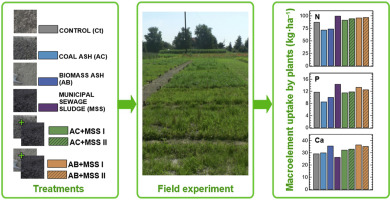当前位置:
X-MOL 学术
›
J. Environ. Manag.
›
论文详情
Our official English website, www.x-mol.net, welcomes your feedback! (Note: you will need to create a separate account there.)
Application of ash and municipal sewage sludge as macronutrient sources in sustainable plant biomass production.
Journal of Environmental Management ( IF 8.7 ) Pub Date : 2020-03-21 , DOI: 10.1016/j.jenvman.2020.110450 Jacek Antonkiewicz 1 , Anna Popławska 1 , Beata Kołodziej 2 , Krystyna Ciarkowska 3 , Florian Gambuś 1 , Maja Bryk 2 , Jacek Babula 1
Journal of Environmental Management ( IF 8.7 ) Pub Date : 2020-03-21 , DOI: 10.1016/j.jenvman.2020.110450 Jacek Antonkiewicz 1 , Anna Popławska 1 , Beata Kołodziej 2 , Krystyna Ciarkowska 3 , Florian Gambuś 1 , Maja Bryk 2 , Jacek Babula 1
Affiliation

|
Owing to the growing volumes of ash and sewage sludge waste, there is a requirement for theoretical and practical research into the use of these wastes as a source of nutrients. However, there are relatively few studies on the transfer of macronutrients in soil-plant systems amended with ash-sewage sludge mixtures under field conditions. The aim of the study was to determine the effect of bituminous coal ash (AC), biomass ash (AB), and municipal sewage sludge (MSS) on the quantity and quality of a grass-legume mixture. During a 6 year field experiment on a sandy loam soil treated with the wastes, applied as mixtures or separately, the plant yield; N, P, K, Na, Mg, and Ca uptake by plants; macronutrient content and ratios in the plant biomass; and the recovery rate of macronutrients by plants were evaluated. The AB-MSS treatment increased the yield in comparison to that where the wastes were applied separately. The N, P, and Ca contents in the plant biomass and N and P uptake under ash-sludge treatments were in the range observed for the ash and sewage sludge. The AB-MSS co-application resulted in the highest K uptake. The AC-MSS treatment increased K and Mg uptake in relation to AC treatment. When AC or AB was added to the MSS, the Ca uptake increased relative to the MSS treatment. The plant biomass under the AB treatment was optimal for biofuel purposes in terms of the chemical composition. The co-application of AC or AB with MSS resulted in the optimum Ca:Mg ratio for fodder purposes. The recovery rate of the macroelements decreased in the following order: K, N, P, Mg, Na, and Ca. The results support the co-application of solid wastes such as ash and municipal sewage sludge to improve productivity, support the recycling of macronutrients, improve sustainability through the reduction of ash and sewage sludge disposal, and reduce reliance on mineral fertilizer.
中文翻译:

灰分和城市污水污泥作为常量营养物源在可持续植物生物量生产中的应用。
由于灰分和污水污泥废物的数量不断增长,因此需要对将这些废物用作营养源的理论和实践研究。但是,在田间条件下,用灰污水污泥混合物修正的土壤-植物系统中大量养分的转移研究很少。该研究的目的是确定烟煤灰(AC),生物质灰(AB)和城市污水污泥(MSS)对草-豆混合物的数量和质量的影响。在为期6年的田间试验中,在用废物处理的沙壤土上,将其作为混合物或单独施用可提高植物的产量;植物对氮,磷,钾,钠,镁和钙的吸收 植物生物量中的大量营养素含量和比例;并评估了植物中大量营养素的回收率。与单独处理废物相比,AB-MSS处理提高了产量。灰渣处理后植物生物量中氮,磷和钙的含量以及氮,磷的吸收量均在灰渣和污水污泥中观察到的范围内。AB-MSS共同施用导致最高的K吸收。与AC处理相比,AC-MSS处理增加了K和Mg的吸收。当将AC或AB添加到MSS中时,相对于MSS处理,Ca吸收增加。就化学组成而言,经过AB处理的植物生物量最适合用于生物燃料。AC或AB与MSS的共同应用可为饲料提供最佳的Ca:Mg比。宏观元素的回收率按以下顺序降低:K,N,P,Mg,Na和Ca。
更新日期:2020-03-22
中文翻译:

灰分和城市污水污泥作为常量营养物源在可持续植物生物量生产中的应用。
由于灰分和污水污泥废物的数量不断增长,因此需要对将这些废物用作营养源的理论和实践研究。但是,在田间条件下,用灰污水污泥混合物修正的土壤-植物系统中大量养分的转移研究很少。该研究的目的是确定烟煤灰(AC),生物质灰(AB)和城市污水污泥(MSS)对草-豆混合物的数量和质量的影响。在为期6年的田间试验中,在用废物处理的沙壤土上,将其作为混合物或单独施用可提高植物的产量;植物对氮,磷,钾,钠,镁和钙的吸收 植物生物量中的大量营养素含量和比例;并评估了植物中大量营养素的回收率。与单独处理废物相比,AB-MSS处理提高了产量。灰渣处理后植物生物量中氮,磷和钙的含量以及氮,磷的吸收量均在灰渣和污水污泥中观察到的范围内。AB-MSS共同施用导致最高的K吸收。与AC处理相比,AC-MSS处理增加了K和Mg的吸收。当将AC或AB添加到MSS中时,相对于MSS处理,Ca吸收增加。就化学组成而言,经过AB处理的植物生物量最适合用于生物燃料。AC或AB与MSS的共同应用可为饲料提供最佳的Ca:Mg比。宏观元素的回收率按以下顺序降低:K,N,P,Mg,Na和Ca。


























 京公网安备 11010802027423号
京公网安备 11010802027423号